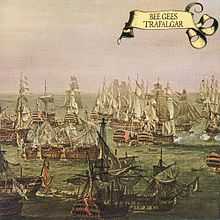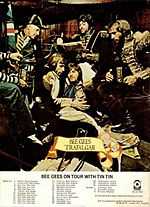Trafalgar (album)
| Trafalgar | ||||
|---|---|---|---|---|
 | ||||
| Studio album by Bee Gees | ||||
| Released |
September 1971 (US) November 1971 (UK) | |||
| Recorded |
28 January – April 1971 IBC Studios, London | |||
| Genre | Soft rock | |||
| Length | 47:28 | |||
| Label |
Polydor (UK) Atco (US, CA) | |||
| Producer | Robert Stigwood, Bee Gees | |||
| Bee Gees chronology | ||||
| ||||
| Singles from Trafalgar | ||||
|
||||
| Professional ratings | |
|---|---|
| Review scores | |
| Source | Rating |
| Allmusic | |
Trafalgar is the Bee Gees' ninth album (seventh internationally), released in September 1971 in the US, and November 1971 in the UK. The album was a moderate hit in the United States, and peaked at No. 34. The lead single "How Can You Mend a Broken Heart?" was the first Bee Gees' No. 1 single in the United States but failed to chart in Britain as did the album. It is also Geoff Bridgford's only full-length appearance on a Bee Gees album as an official member.
Trafalgar is noted in Robert Dimery's book 1001 Albums You Must Hear Before You Die.[2]
Background
In December 1970, barely more than two months after the group recorded their last session for the 2 Years On album, they recorded "Together", "Over the Hill and Over the Mountain", "Merrily Merry Eyes" and "When Do I". On January 11, 1971, Maurice Gibb contributed writing, producing and play guitar on Lulu's 1971 single "Everybody Clap" with Jack Bruce of Cream and Maurice's friend, John Bonham of Led Zeppelin on drums.[3] The group also did the 2 Years On Tour to support their album.
Recording
They returned to the studio with new backing band member guitarist Alan Kendall, who remained as lead guitarist with the Bee Gees until their final album This Is Where I Came In in 2001. Although the Gibb Brothers had reunited in 1970, they were still working separately as evident in the writing credits. Several songs were recorded around this time, many of which have never officially been released. All of the songs chosen for release were ballads, which gives the album something of a concept feeling. The group started to record for this album on 28 January 1971 when they recorded "We Lost the Road", "When Do I" and "How Can You Mend a Broken Heart" ("We Lost the Road" was not included on this album and released in 1972 on their next album). Recording continued through April with several demos and outtakes recorded but never released.[3]
Release

With "How Can You Mend a Broken Heart" as the lead single from the album, "Don't Wanna Live Inside Myself" was released as the second single and only reached No. 57 on the USA charts. "Israel" was only released in the Netherlands and reached No. 22. The album's cover is The Battle of Trafalgar. Bridgford was credited on the sleeve notes on the original vinyl release as "Jeoff Bridgford".[4]
In the support of the album, The Bee Gees toured the US in the fall of 1971, playing such cities as Boston, Asbury Park, New York City (7 shows), Memphis, Kansas City, and Indianapolis.
Track listing
| Side one | ||||||||||
|---|---|---|---|---|---|---|---|---|---|---|
| No. | Title | Writer(s) | Lead vocal(s) | Length | ||||||
| 1. | "How Can You Mend a Broken Heart" | Barry Gibb, Robin Gibb | Robin and Barry | 3:58 | ||||||
| 2. | "Israel" | B. Gibb | Barry | 3:54 | ||||||
| 3. | "The Greatest Man in the World" | B. Gibb | Barry | 4:18 | ||||||
| 4. | "It's Just the Way" | Maurice Gibb | Maurice | 2:34 | ||||||
| 5. | "Remembering" | B. Gibb, R. Gibb | Robin | 4:02 | ||||||
| 6. | "Somebody Stop the Music" | B. Gibb, M. Gibb | Barry and Maurice | 3:31 | ||||||
| Side two | ||||||||||
|---|---|---|---|---|---|---|---|---|---|---|
| No. | Title | Writer(s) | Lead vocal(s) | Length | ||||||
| 7. | "Trafalgar" | M. Gibb | Maurice | 3:53 | ||||||
| 8. | "Don't Wanna Live Inside Myself" | B. Gibb | Barry | 5:25 | ||||||
| 9. | "When Do I" | B. Gibb, R. Gibb | Robin | 3:58 | ||||||
| 10. | "Dearest" | B. Gibb, R. Gibb | Barry and Robin | 3:52 | ||||||
| 11. | "Lion in Winter" | B. Gibb, R. Gibb | Barry and Robin | 3:59 | ||||||
| 12. | "Walking Back to Waterloo" | B. Gibb, R. Gibb, M. Gibb | Barry, Robin & Maurice | 3:51 | ||||||
Alternate version
- This 53-minute version of the album was sent to Atlantic Records in the US with a different track order and with 14 songs in total. The two extra songs are "Country Woman" (a non-album song) and "We Lost the Road" (released on the group's next album To Whom It May Concern). There was no commercial release of the album in this state.
- Side one
- "How Can You Mend a Broken Heart"
- "Israel"
- "The Greatest Man in the World"
- "It's Just the Way"
- "Don't Wanna Live Inside Myself"
- "Country Woman"
- "Somebody Stop the Music"
- Side two
- "Trafalgar"
- "We Lost the Road"
- "Dearest"
- "When Do I"
- "Lion in Winter"
- "Remembering"
- "Walking Back to Waterloo"
Personnel
- Bee Gees
- Barry Gibb — lead, harmony and backing vocal, rhythm guitar
- Robin Gibb — lead, harmony and backing vocal
- Maurice Gibb — harmony and backing vocal, bass, piano, mellotron, guitar, organ, lead vocal on "It's Just the Way" and "Trafalgar" and drums on "Trafalgar"
- Geoff Bridgford – drums
- Additional personnel and production
- Alan Kendall — lead guitar
- Bryan Scott — engineer
- Bill Shepherd – orchestral arrangement
Charts
Peak positions
|
Year-end charts
|
References
- ↑ Allmusic review
- ↑ 1001 Albums You Must Hear Before You Die. New York, NY: Universe, 2006. pg 165. (ISBN 0-7893-1371-5)
- ↑ 3.0 3.1 Joseph Brennan. "Gibb Songs: 1971".
- ↑ Hughes, Andrew. The Bee Gees - Tales of the Brothers Gibb. Retrieved 7 February 2015.
- ↑ Kent, David. Australian Chart Book 1970–1992. Australian Chart Book. ISBN 0-646-11917-6.
- ↑ "Top Albums/CDs - Volume 16, No. 10". RPM. 23 October 1971. Retrieved 5 May 2013.
- ↑ 7.0 7.1 "Hit Parade Italia - Gli album più venduti del 1972" (in Italian). hitparadeitalia.it. Retrieved 5 May 2013.
- ↑ Oricon Album Chart Book: Complete Edition 1970-2005. Roppongi, Tokyo: Oricon Entertainment. 2006. ISBN 4-87131-077-9.
- ↑ Salaverri, Fernando (September 2005). Sólo éxitos: año a año, 1959–2002 (1st ed.). Spain: Fundación Autor-SGAE. ISBN 84-8048-639-2.
- ↑ "Allmusic: Trafalgar : Charts & Awards : Billboard Albums". allmusic.com. Retrieved 5 May 2013.